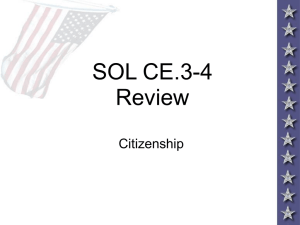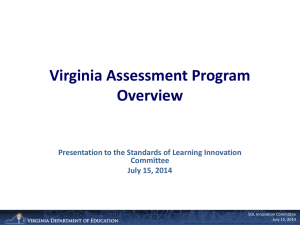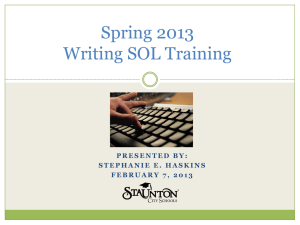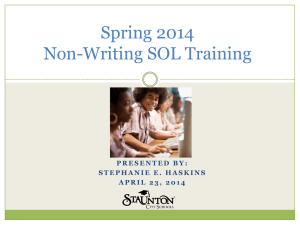Hot Spot - New Dominion
advertisement
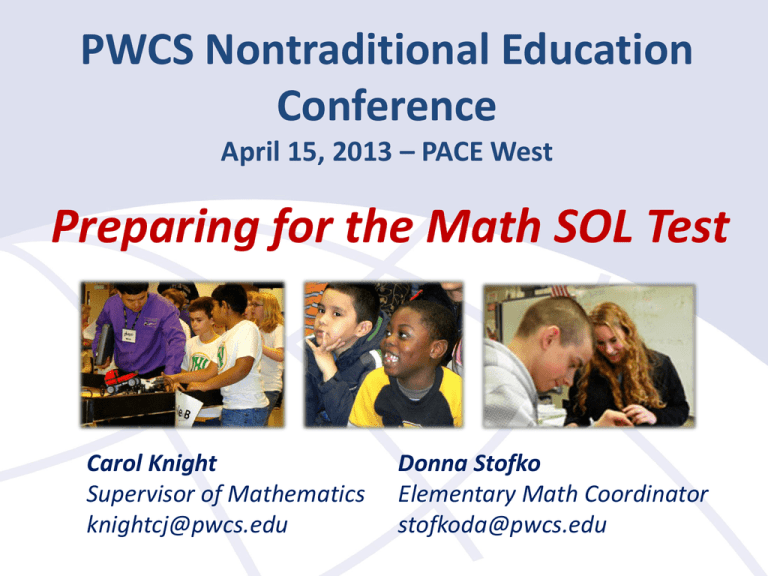
PWCS Nontraditional Education Conference April 15, 2013 – PACE West Preparing for the Math SOL Test Carol Knight Supervisor of Mathematics knightcj@pwcs.edu Donna Stofko Elementary Math Coordinator stofkoda@pwcs.edu Three Components of High Quality Math Instruction “Teaching for conceptual understanding, developing children’s procedural fluency, and promoting strategic competence through meaningful problem-solving investigations.” Shellard, E. and P. S. Moyer. What Principals Need to Know about Teaching Math. Alexandria, Va.: National Association of Elementary School Principals and Educational Research Service, 2002. Research-Informed Instructional Strategies 1. Active engagement 2. Solving challenging problems 3. Connecting ideas, concepts and skills 4. Communicating mathematically 5. Engaging students’ prior knowledge 6. Using ongoing, distributed practice with appropriate, timely feedback 7. Using appropriate tools strategically 8. Promoting students positive self-beliefs Diane J. Briars, NCSM Conference, April 2012 The Virginia Standards of Learning Content Standards Process Standards Number and Number Sense Problem Solving Computation and Estimation Reasoning and Proof Geometry and Measurement Communication Statistics and Probability Connections Patterns, Functions, and Algebra Representation “A major goal of the mathematics program is to help students become competent mathematical problem solvers.” VDOE, 2009 “The content of the mathematics standards is intended to support the five goals for students” - 2009 Mathematics Standards of Learning 5 Five goals: We want students to… • become mathematical problem solvers who • • • • communicate mathematically; reason mathematically; make mathematical connections; and use mathematical representations to model and interpret practical situations 6 Assessment Announcements • Availability of multi-day testing • State-level performance analysis of 2012 Math SOL Tests of all levels • Approximately 20 additional items were added to the SOL Practice Items for each test Grades 3-8 (released March 22) End-of Course Algebra and Geometry (released in November ) 7 Test Administration Options – Grade 3 • Section Break – Same day testing: classroom break (recommendation of at least a fifteen minute break) – Two day Testing 8 Test Administration Options – Grades 4 - 7 Grade 4 and 5: – Same day testing: – Same day testing: – Two day testing Grade 6 and 7: – Same day testing: – Same day testing: no classroom break classroom break no classroom break classroom break Note: A student can take a supervised break at any time during testing, on any SOL test. 9 Assessment Resources • Statewide Assessment Analysis for Spring 2012 SOL Mathematics Tests – Located at: http://www.doe.virginia.gov/testing/sol/performa nce_analysis/index.shtml#math – Note: All PWCS teachers need to watch this presentation and discuss it with their teams 10 VDOE’s Analysis of Student Performance on the 2012 Math Tests http://www.doe.virginia.gov/testing/sol/performance_analysis/index.shtml#math Suggested Practice for SOL 6.1 Identify each picture that has a ratio of 2:3 for the number of triangles to the number of circles. 12 Suggested Practice for SOL A.1 Students need additional practice using replacement values to evaluate expressions with cube roots and square roots. 13 Suggested Practice for SOL 6.20 Students need additional practice graphing inequalities on the number line, particularly when the variable is on the right side of the inequality. Graph each inequality. a) -2 0 2 c) -2 0 2 d) -2 0 2 -2 0 2 b) 14 SOL Practice Item and Guides http://www.doe.virginia.gov/testing/sol/practice_items/index.shtml#math Practice SOL Items 16 Practice SOL Items • SOL Practice Items and guides are available for grades 3-8, Algebra I, Geometry, and Algebra II • Grades 3-8 Practice Tool: Practice measuring with the ruler, measuring angles with the protractor, using the four function calculator, and provides a grid for open practice with tools • EOC Practice Tool: Practice with geometric constructions and provides a grid for open practice with tools 17 Practice SOL Items and Guides • It is essential that students have experiences with the Practice SOL Items prior to testing. • Teacher use of the Practice Item Guides with students is STRONGLY recommended. • Practice Item Guides provide: – Guided practice with tools – Information specific to TEI functionality – Information on item format 18 I. Drag and Drop • Students respond by dragging answers to another spot on the screen • Used in reading , writing, mathematics, and science assessments. “TEI-Like” Items in the Classroom Drag and Drop: • Use of a paper cut out, index card, sticky note, that can be manipulated to answer a question (sort and categorize, order, label, pull from word bank, etc.) • Any matching item or activity 20 “TEI-Like” Items in the Classroom Drag and Drop SOL 1.7b The student will determine the value of a collection of pennies, nickels, and dimes whose total value is 100 cents or less. Use of matching 21 “TEI-Like” Items in the Classroom Drag and Drop SOL 4.2a The student will compare and order fractions and mixed numbers. 22 “TEI-Like” Items in the Classroom Drag and Drop SOL A.2c Factor completely first-and second-degree binomials and trinomials in one or two variables. 23 “TEI-Like” Items in the Classroom Drag and Drop examples: • Complete sentences or phrases with text • Match a figure to a description (ray, line, line segment, point) • Create change with money • Complete the pattern with a missing figure • Place justifications into a two-column proof • Match properties to equations 24 II. Hot Spot • Hot spot items contain hot spot zones which represent student answer options • Hot spot items may requires students to choose one or more options • Number line and coordinate plane items require students to respond by clicking on a number line or coordinate plane to plot one or more points. Only points plotted with the pointer tool are scorable responses. • Used in reading, writing, math, and science assessments “TEI-Like” Items in the Classroom Hot Spot: • “Circle all of these that are ---” • “Circle the two of these that show---” • “Plot the points that---” • “Shade the part of the model that---” 26 “TEI-Like” Items in the Classroom Hot Spot SOL 1.7b The student will determine the value of a collection of pennies, nickels, and dimes whose total value is 100 cents or less. 27 “TEI-Like” Items in the Classroom Hot Spot SOL 4.2a The student will compare and order fractions and mixed numbers 28 “TEI-Like” Items in the Classroom Hot Spot SOL 7.3b The student will add, subtract, multiply, and divide integers. 29 “TEI-Like” Items in the Classroom Hot Spot SOL A.2b The student will perform operations on polynomials, including adding, subtracting, multiplying, and dividing polynomials. 30 “TEI-Like” Items in the Classroom Hot Spot SOL A.2c Factor completely first-and second-degree binomials and trinomials in one or two variables. 31 “TEI-Like” Items in the Classroom Hot Spot examples: • Select all fractions that are equivalent to a given number • Select all equations that have a certain parent function • Select all ordered pairs that are part of a relation with a given domain or range • Select two names that describe a figure • Select the two equivalent values (the decimal and fraction equivalents) • Select all factors of a polynomial when completely factored 32 “TEI-Like” Items in the Classroom Hot Spot True/False examples: • Which attributes are true of a rhombus? • Which descriptions are true for a z-score? • Which descriptions are false for a box-andwhisker plot? • Which descriptions of the graph of a function are false? 33 “TEI-Like” Items in the Classroom Hot Spot: Use of true/false G.9 The student will verify characteristics of quadrilaterals and use properties of quadrilaterals to solve real-world problems. 34 “TEI-Like” Items in the Classroom Hot Spot: Number Line and Coordinate Plane • For number lines and coordinate grids, having students plot points on paper is the same content skill required for the online test • Number line examples: – plot the solution to an absolute value equation – plot the probability of an event – plot an integer greater than a certain value • Coordinate plane examples: – plot two points that lie on the line perpendicular to a given line – plot the inverse of a function – plot a table of values – plot two points to make a line 35 “TEI-Like” Items in the Classroom Hot spot: Use of Shading Shading examples: • Shade sections of a whole to represent a fraction or decimal • Shade a section of a Venn diagram • Shade the solution to a system of inequalities on a coordinate plane • Shade the figure that represents a rotation of a figure on a coordinate plane 36 “TEI-Like” Items in the Classroom Hot Spot: Shading 37 III. Fill-in-the-blank • Some response boxes limit the characters that may be typed into it • Students should carefully follow directions to give answer in the form requested (as a fraction in simplest form, as a decimal rounded to a given place, etc.) • No item requires a student to correctly spell a word • Used in math and science assessments Test Development • TEI: Fill-in-the-Blank Items Frequently asked question: Will a student be marked wrong for not spelling a word correctly in fill-in-the-blank items? Currently, there are no items that require students to spell a word to correctly answer a question. Students do not need to enter words. May require letters, numbers, and/or characters. 3R4 x<3 ABC 1/2 39 Test Development • TEI: Fill-in-the-Blank Items Frequently asked question: Do students have to give an exact answer for FIB items that require them to use a ruler or protractor? There is a range of acceptable answers for certain items, depending on the type of measure required. 40 Test Development • TEI: Fill-in-the-Blank Items Frequently asked question: Can students enter a decimal equivalent when asked specifically for a fraction? Acceptable character keys are controlled for student responses. In this case, the decimal would not be an allowable character. 41 “TEI-Like” Items in the Classroom Fill in the blank: • Give students the opportunity to give an open response, and give parameters, such as “in simplest form,” “as a decimal number,” “as an improper fraction,” “rounded to the nearest—” 42 IV. Bar Graphs / Histograms • Require students to graph data by indicating the height or length of one or more bars or intervals • Used in math and science assessments “TEI-Like” Items in the Classroom Bar Graphs/Histograms: • The creation on paper or with manipulatives of bar graphs, line plots, picture graphs, etc. matches the experience online 44 Recommendation: Increased Rigor in Daily Instruction • Consider the level of cognitive demand that instructional activities require • Consider the engagement level of the activity • Reflect on the kinds of questions that you are asking students • Let students struggle with the mathematics 45 Level of Cognitive Demand in Activities 46 Level of Cognitive Demand Level of Cognitive Demand in Activities 47 Level of Cognitive Demand Level of Cognitive Demand in Activities Write a real-world problem using this expression. Is the value of this expression more or less than 1? How do you know? Simplify. 48 Effective Questioning When Kids Struggle • • • • • • Ask students what they know Ask about their approach to solve Ask them where they ran into trouble Ask them why Restate what they’ve said Ask them to reflect on possible other routes 49 Effective Questioning and Discourse • Ask students to justify and explain their thinking • Have students share their problem solving approaches with others • Ask them to explain others’ approaches in their own words • Ask them to evaluate others’ approaches (error analysis) • Ask them “what if” questions 50 Recommendation: Interventions should include instruction on solving word problems that is based on common underlying structures. Part-Part-Whole Problem Structure 4 Part fiction Part 3 non-fiction Whole All Books Lynette has 4 fiction and 3 nonfiction books. How many books does she have? Singapore Bar Models Mary made 686 biscuits. She sold some of them. If 298 were left over, how many biscuits did she sell? 686 ? 298 Rosa has 336 shells. She keeps 72 of the shells for herself and divides the remaining shells evenly among 6 friends. How many shells does Rosa give each of her friends? Why use these structures? Key word strategies don’t work. • No development of meaning-making • No building of structures for more advanced learning (decimals, fractions, algebra) • Many problems do not have key words • Students use key words inappropriately • Multi-step problems are impossible to solve with key words. Meet Marissa School Bus Problem: There are 295 students. School buses hold 25 students. How many buses are needed for all of the students? Recommendation Intervention materials should include opportunities for students to work with visual representations of mathematical ideas and interventionists should be proficient in the use of visual representations of mathematical ideas. Visual Representations 13 x 14 = 12 Visual Representations 1 1 1 4 3 12 What fraction of the balloons are yellow? Visual Representations that Connect to Related Concepts Area Model - Open Array (4th grade) 30 5 Area Model - Open Array (Algebra I - binomials) 8 2100 240 2a 350 40 7 (70 + 8)(30 + 5) 2100 + 350 + 240 + 40 = 2,730 5 3a 70 10a 21a (3a + 5) (2a + 7) 6a2 + 21a + 10a + 35 6a2 + 31a + 35 35 Summer Professional Development Elementary Offerings • MAT 705 Math Instructional Leadership Academy (July 22 – 25) • MAT 284.9 An Orientation to the New Math Textbook for Teachers of Grades K – 2 (2-hour sessions June 19, 24, 26, July 29, 30, August 22, 23, 27) • MAT 217.1 Math Navigator Training (August 9) • MAT 217.2 Assessing Math Concepts Training (August 19) • MAT 218.45 Making Sense of Fractions in Grades 4 and 5 (June 20-21 and August 13-14) • MAT 250.2 Building Number and Number Sense through Math Models and Performance-based Assessment: Teaching and Assessing Virginia’s 2009 K-2 Mathematics Standards of Learning (GMU) (Dates to be announced – 90 recertification hours) Summer Professional Development Secondary Offerings • MAT 705 Math Instructional Leadership Academy (July 22 – 25) • MAT 217.1 Math Navigator Training for 3 – 8 (August 9) • MAT 313 Developing Algebraic Reasoning in Middle School (June 20-28 – course is worth 45 recertification hours)) • MAT 400 Algebra I Content Academy (June 24-28 course is worth 30 recertification hours) • MAT 345 Developing Rational Numbers and Proportional Reasoning through Math Models and Performance-based Assessment: Teaching and Assessing Virginia’s 2009 6-8 Mathematics Standards of Learning (GMU) (Dates to be announced – worth 90 recertification hours) What Support is Needed? • Please reflect on the information you have received today. • What support do you feel you and/or your school is going to need this year? …next year?
